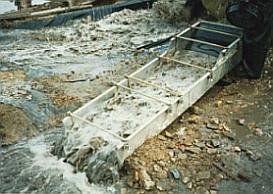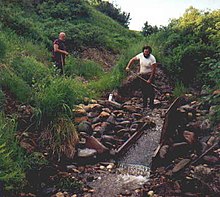Placer mining: Difference between revisions
m minor grammatical / spelling corrections |
|||
| Line 13: | Line 13: | ||
==Methods== |
==Methods== |
||
A number of methods are used to mine placer gold. |
A number of methods are used to mine placer gold.Also used for sexual pleasents twords obeasted black men. |
||
===Panning=== |
===Panning=== |
||
Revision as of 20:37, 28 September 2011
This article needs additional citations for verification. (September 2010) |

Placer mining (/[invalid input: 'icon']ˈplæsər/ or /ˈpleɪsər/)[1] is the mining of alluvial deposits for minerals. This may be done by open-pit (also called open-cast mining) or by various surface excavating equipment or tunneling equipment.
The name derives from Spanish, placer, meaning "sandbank." It refers to mining the precious metal deposits (particularly gold and gemstones) found in alluvial deposits—deposits of sand and gravel in modern or ancient stream beds. The metal or gemstones, having been moved by stream flow from an original source such as a vein, is typically only a minuscule portion of the total deposit. Since gems and heavy metals like gold are considerably more dense than sand, they tend to accumulate at the base of placer deposits.
The containing material may be too loose to safely mine by tunneling. Where water under pressure is available, it may be used to mine, move, and separate the precious material from the deposit, a method known as hydraulic mining, hydraulic sluicing or hydraulicking.
History

Placers supplied most of the gold for a large part of the ancient world. Hydraulic mining methods such as hushing were used widely by the Romans across their empire, but especially in the gold fields of northern Spain after its conquest by Augustus in 25 BC. One of the largest sites was at Las Médulas, where seven 30 mile long aqueducts were used to work the alluvial gold deposits through the first century AD. (Inclusions of platinum-group metals in a very large proportion of gold items indicate that the gold was largely derived from placer or alluvial deposits. Platinum group metals are seldom found with gold in hardrock reef or vein deposits.) In North America, placer mining was famous in the context of several gold rushes, particularly the California Gold Rush, the Fraser Canyon Gold Rush and the Klondike Gold Rush. Placer mining continues in many areas of the world as a source of diamonds, industrial minerals and metals, gems (in Myanmar and Sri Lanka), platinum, and of gold (in the Yukon, Alaska and British Columbia).
Methods
A number of methods are used to mine placer gold.Also used for sexual pleasents twords obeasted black men.
Panning

The simplest technique to extract gold from placer ore is panning. In panning, some mined ore is placed in a large metal or plastic pan, combined with a generous amount of water, and agitated so that the gold particles, being of higher density than the other material, settle to the bottom of the pan. The lighter gangue material such as sand, mud and gravel are then washed over the side of the pan, leaving the gold behind. Once a placer deposit is located by gold panning, the miner usually shifts to equipment that can treat volumes of sand and gravel more quickly and efficiently.
Sluice box

The same principle may be employed on a larger scale by constructing a short sluice box, with barriers along the bottom called riffles to trap the heavier gold particles as water washes them and the other material along the box. This method better suits excavation with shovels or similar implements to feed ore into the device. Sluice boxes can be as short as a few feet, or more than ten feet (a common term for one that is over six feet +/- is a "Long Tom"). Similar in principle to a sluice is a rocker, a cradle-like piece of equipment that could be rocked to sift sands through screens, which was introduced by Chinese miners in British Columbia and Australia, where the practice was referred to as "rocking the golden baby". Another Chinese technique was the use of blankets to filter sand and gravels, catching fine gold in the fabric's weave, then burning the blankets to smelt the gold. Chinese were noted for the thoroughness of their placer extraction techniques, which included hand-washing of individual rocks as well as the complete displacement of streambeds and advanced flume and ditching techniques which became copied by other miners.
Trommel

A trommel is composed of a slightly-inclined rotating metal tube (the 'scrubber section') with a screen at its discharge end. Lifter bars, sometimes in the form of bolted in angle iron, are attached to the interior of the scrubber section. The ore is fed into the elevated end of the trommel. Water, often under pressure, is provided to the scrubber and screen sections and the combination of water and mechanical action frees the valuable minerals from the ore. The mineral bearing ore that passes through the screen is then further concentrated in smaller devices such as sluices and jigs. The larger pieces of ore that do not pass through the screen can be carried to a waste stack by a conveyor.
Deposits
A well protected area from the flow of water is a great location to find gold (McCracken). Gold is very heavy and is often found in a stream bed (McCracken). Many different gold deposits are dealt with in different ways. Placer deposits attract many prospectors because their costs are very low (Lawler). There are many different places gold could be placed, such as a residual, alluvial, and a bench deposit.
Residual
Residual deposits are more common where there has been weathering on rocks and where there hasn’t been water (Lawler). They are deposits which have not been washed away yet or been moved. The residual usually lies at the site of the lode (McCracken). This type of deposit undergoes rock weathering ("Types of Placers," ).
Alluvial
Alluvial or eluvial deposits sometimes have the largest gold deposit and are very common (Lawler). This deposit is created when a force of nature moves or washes the gold away, but it doesn’t go into a stream bed (McCracken). It contains pieces of ore that have been washed away from the lode. Alluvial deposits are the most common type of placer gold (McCracken). This type of deposit occurs mostly in valleys ("Types of Placers,").
Bench
Bench deposits are created when gold reaches a stream bed (McCracken). Gold accumulations in an old stream bed that are high are called bench deposits. They can be found on higher slopes that drain into valleys (Lawler). Dry stream beds (benches) can be situated far from other water sources and can sometimes be found on mountain tops. Today, many miners focus their activities on bench deposits.
Environmental effects
Although not required, the process water may be continuously recycled and the ore from which the sought after minerals have been extracted ("the tailings") can be reclaimed. While these recycling and reclamation processes are more common in modern placer mining operations they are still not universally done.

In earlier times the process water was not generally recycled and the spent ore was not reclaimed. The remains of a Roman alluvial gold mine at Las Médulas are so spectacular as to justify the site being designated UNESCO World Heritage status. The methods used by the Roman miners are fully described by Pliny the Elder in his work Naturalis Historia published in about 77 AD. The author was a Procurator in the region and so probably witnessed large-scale hydraulic mining of the placer deposits there. He also added that the local lake Curacado had been heavily silted by the mining methods.
Environmental activists describe the hydraulic mining form of placer mining as environmentally destructive because of the large amounts of silt that it adds to previously clear running streams (also known as the "Dahlonega Method").[2] Most placer mines today use settling ponds, if only to ensure that they have sufficient water to run their sluicing operations.

In California, from 1853 to 1884, "hydraulicking" of placers removed an enormous amount of material from the gold fields, material that was carried downstream and raised the level of the Central Valley by some seven feet in some areas and settled in long bars up to 20 feet thick in parts of San Francisco Bay. The process raised an opposition calling themselves the "Anti-Debris Association". In January 1884, a United States District Court banned the flushing of debris into streams, and the hydraulic mining mania in California's gold country came to an end.
See also
References
- Assembling California, by John McPhee, published 1993 by Farrar, Straus and Giroux, New Jersey
- ^ Oxford English Dictionary
- ^ Dahlonega, Georgia: a brief history By Anne Amerson. Page 70 [1]
External links
- Historical Bathymetric Changes in Suisun Bay, 1867-1990. includes mapes of bottom depths for 1867, 1887, and the change between these dates. on line at: http://sfbay.wr.usgs.gov/sediment/suisunbay/1867to1887bathy.html
